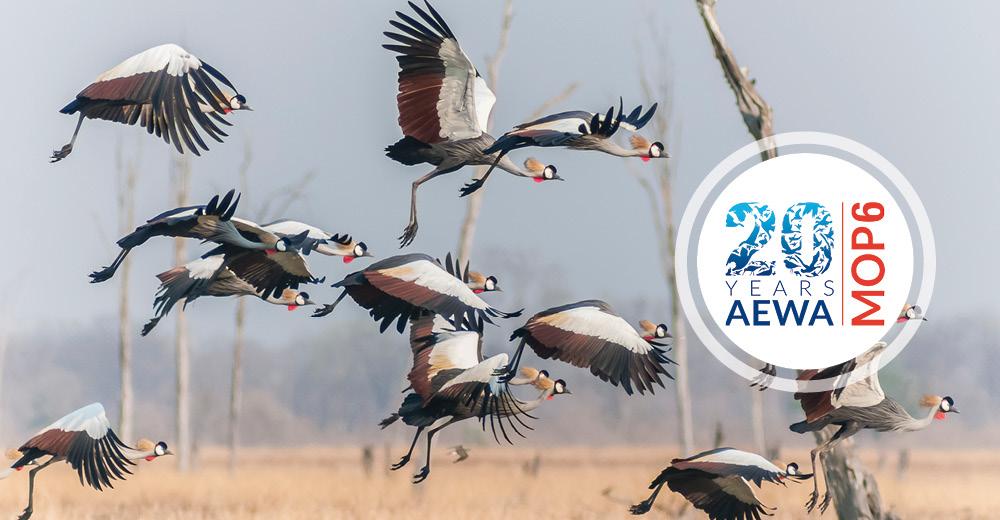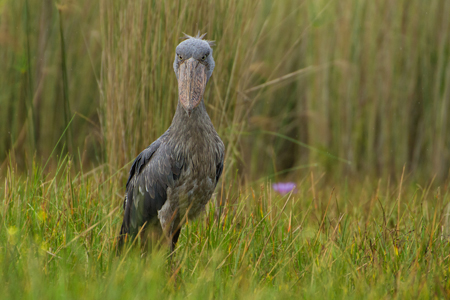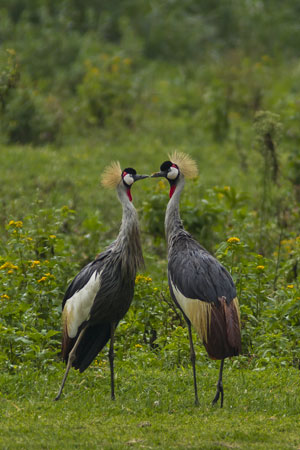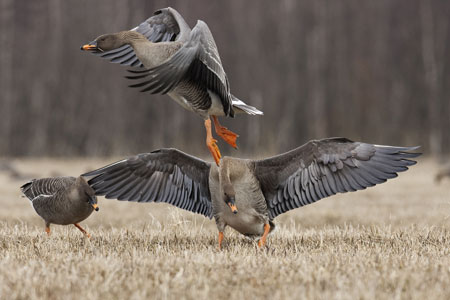Concerted Action and Sustainable Management of AEWA’s Waterbirds

Grey Crowned-cranes (Balearica regulorum) © Wim Werrelman
Bonn, 10 November 2015 - The Agreement on the Conservation of African-Eurasian Migratory Waterbirds (AEWA) is holding its 6th Meeting of the Parties (MOP6) in Bonn, Germany, from 9 to 14 November 2015. AEWA is an inter-governmental treaty bringing together 75 Parties and is administered by the United Nations Environment Programme (UNEP) dedicated to the conservation and sustainable use of migratory waterbird species that migrate from the remote Arctic to the Southern tip of Africa. At MOP6, the governments of Parties to AEWA will decide on urgently needed conservation and management actions in an effort to ensure the long-term survival of the 255 migratory species covered by the Agreement.
While the conservation status of many species unfortunately continues to deteriorate, improvements can be noted in cases where concerted measures and actions are being undertaken: this is the role of the “International Single Species Action Plans” developed under AEWA to ensure the conservation of prioritized waterbird species along their flyways, fostering international cooperation amongst a vast range of countries in Africa and Eurasia. At MOP6, six new International Single Species Action Plans will be presented to the Parties for adoption for the following species: the Shoebill, the Grey Crowned-crane, the Taiga Bean Goose, the Long-tailed Duck, the Northern Bald Ibis and the Eurasian Curlew. A short overview of the status of some of these species might help better understand the threats they are facing and the difficulties encountered when trying to protect them efficiently – and thus, the indispensable cooperation that is needed to save them.
The Shoebill

The Shoebill (Balaeniceps rex) is a large unique waterbird living in freshwater swamps of eastern central tropical Africa, with a low world population, estimated at 5,000 - 8,000 birds. As the Shoebill has clearly been in decline in several areas, it is listed as Vulnerable on the IUCN Red List. The Shoebill occurs from South Sudan and Ethiopia in the north to northern Zambia in the south. It feeds mainly on fish and is a long-lived bird whose pairs usually only raise one chick per breeding season. Shoebills are particularly vulnerable when swamps start to dry out during their nesting period; breeding success is largely impacted by anthropogenic factors: mainly disturbance by livestock and people and destruction of nests and wider breeding areas by fire. Habitat conversion, degradation and disappearance constitute a significant threat to the bird’s long-term survival.
Shoebills are also threatened by the live bird trade. They are valuable prehistoric-looking creatures, and the almost complete absence of breeding success in captivity helps maintain a constant pressure on the wild population in order to meet demand. Shoebills are highly sensitive birds, and past exports have involved high mortality during capture, transit and captivity. Another significant threat to Shoebills is oil exploration and extraction, especially in the Sudd Wetlands in South Sudan, where significant developments have taken place, along with the dredging of access canals, which affect the hydrology of the swamps. Agricultural developments also threaten important Shoebill areas, notably at Gambella in western Ethiopia. Overall, the conversion of swamps to agriculture and other land uses remains a major long-term threat, whilst the wider impacts of climate change are likely to exacerbate this and other threats.
Although a high proportion of Shoebills reside in Ramsar sites, national protected areas and IBAs, this does not mean they are protected; resources and capacity to manage extensive swamps are severely limited.
To ensure the conservation of this species, the proposed action plan has identified a number of objectives, such as removing the factors lowering productivity, or reducing the fragmentation and deterioration of habitat. Maintaining trade bans, strengthening surveillance and raising awareness, restricting livestock from core breeding areas, investing communities with conservation responsibilities and promoting community enterprises, notably ecotourism initiatives, are some of the actions that will help deliver these results. International cooperation and coordination are essential for conservation actions to be effective, hence the need for relevant authorities and stakeholders to work collaboratively to implement the actions.
The Grey Crowned-crane

The Grey Crowned-crane (Balearica regulorum)is the icon of Africa’s wetlands and grasslands. It can be found from Uganda and Kenya in the north to South Africa. Due to a decline of the species of up to 80 per cent over the past 45 years, the species is now listed as Endangered on the IUCN Red List.
Grey Crowned-cranes are dependent on wetlands for nesting. Omnivorous, they forage in wetlands, grasslands and in open savannas, preferring grass seeds, insects and other invertebrates. They are also highly opportunistic and are often found foraging on agricultural land. At night, and when resting during the day, Grey Crowned-cranes can most often be found in tall trees or on tall infrastructure, such as electricity poles or pylons.
Grey Crowned-cranes, due to their charisma and beauty, are highly sought after for the captive trade market, where they often have low productivity and relatively high mortality rates. As a result, there is a constant pressure on wild populations across Africa for chicks. Also contributing to reduced breeding success is human disturbance which keeps adult cranes from tending to nests and their chicks. These two threats are further exacerbated by habitat loss and degradation of the wetlands on which they depend, most often caused by agricultural encroachment, afforestation, changes in hydrology, mining and siltation. Although there are several other threats to the species, the collision and electrocution of cranes with power lines are other significant threats, and have the potential to significantly increase as many parts of Africa undergo electrification.
The International Single Species Action Plan developed under AEWA for the Grey Crowned-crane proposes actions to maintain and improve the conservation status of the species, such as improving enforcement of legislation, increasing awareness on a range of issues, addressing the crane trade, reducing the impact of power lines, securing sites important to cranes, and ensuring sustainable management and use of key sites. It will only be through a highly collaborative approach involving governments, NGOs, research institutions, zoos, power utility companies and other organizations, in a multi-disciplinary and multi-pronged manner that the future of Grey Crowned-cranes in Africa will be secured.
The Taiga Bean Goose – a Case of Sustainable Harvest

The proposed AEWA International Single Species Action Plan for the Taiga Bean Goose (Anser fabalis fabalis) is the first flyway conservation plan under the Agreement for a species in decline which is still open for hunting. Taiga Bean Geese breed discontinuously in the boreal zone from Fennoscandia to Western Siberia and winter in North-west Europe and Central Asia. The Taiga Bean Goose is one of the few declining goose populations in the Western Palearctic; the wintering population size, estimated at 100,000 birds in the mid-1990s, had decreased to 63,000 by 2009. The Bean Goose is globally categorized as a species of Least Concern on the IUCN Red List, because no distinction is made between the subspecies, and the population of the Tundra Bean Goose (Anser f. rossicus) is considered stable and is much more abundant than the Taiga Bean Goose. Under AEWA, however, a distinction is made between the subspecies; this categorization means that hunting of the Taiga Bean Goose may still continue on the basis of sustainable use basis within the framework of an International Single Species Action Plan.
Both legal and illegal harvest, human disturbance, and the loss, fragmentation and degradation of suitable habitat due to forestry, infrastructure development and other human-related factors are considered significant threats to Taiga Bean Geese.
Appropriate international organizational and management structures are vital to the successful and coordinated implementation of International Single Species Action Plans. To this end, an inter-governmental AEWA Taiga Bean Goose International Working Group will be convened following the adoption of the plan to coordinate and guide its implementation and further development of the actions foreseen.
Truly sustainable use can be achieved only at the flyway level by involving all Range States where this population is being hunted. This Action Plan is the tool ensuring a coordinated and agreed approach to the sustainable use of the Taiga Bean Goose along its entire flyway.
In order to regulate the harvest of migratory waterbirds, AEWA has developed Guidelines on Sustainable Harvest. A revised version of these guidelines will be presented at MOP6. The harvesting of waterbirds in all its modes and motivations can provide both threats and opportunities for the conservation of waterbirds. These guidelines are not intended to be exhaustive, but they do demonstrate the principles by which managers and users of huntable waterbirds can minimize the threats and maximize the opportunities. These guidelines also demonstrate that effective flyway-wide management is achievable, as demonstrated by the success of the first examples of adaptive management of migratory waterbirds that have recently been implemented in the AEWA region, which highlight new opportunities for coordinated management.
Last updated on 10 November 2015


